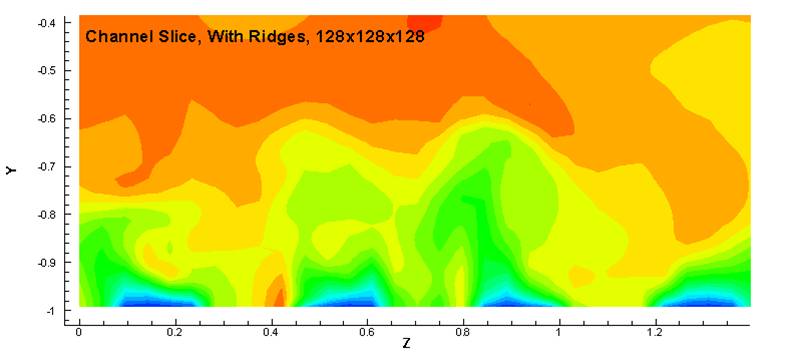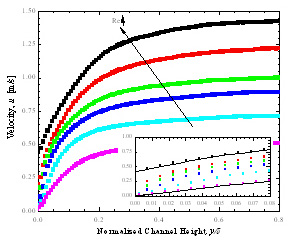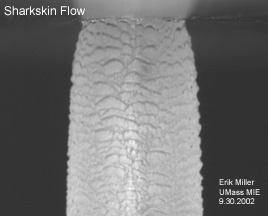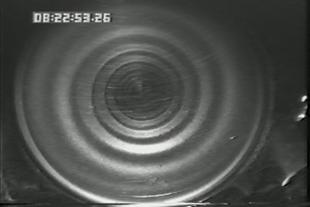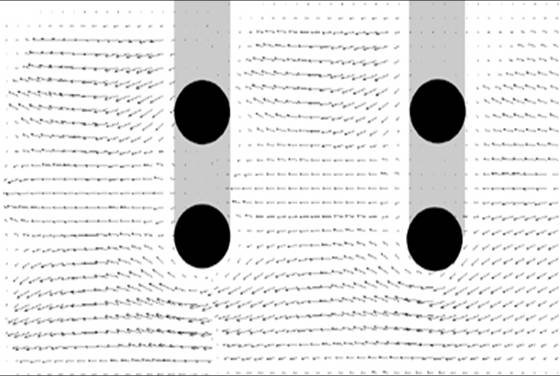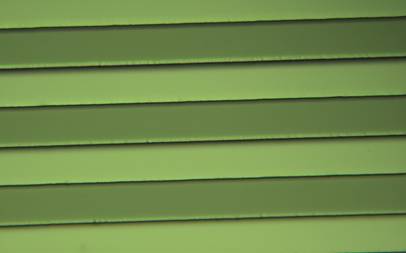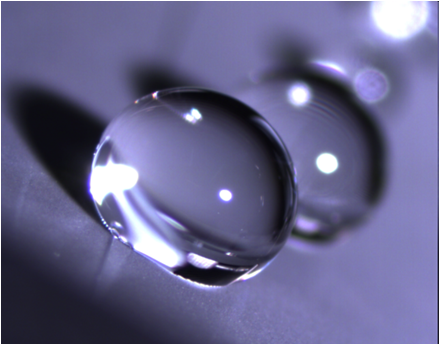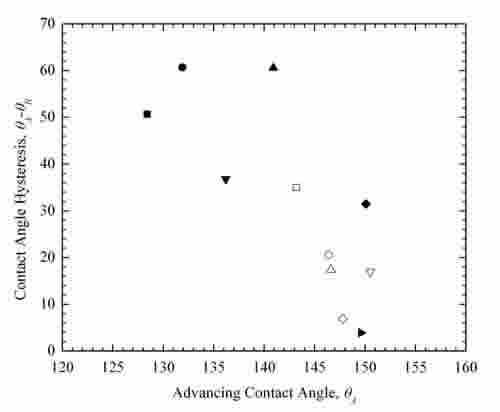 |
|
|
|
|
|
|
|
|
|
|
|
|
|
|
|
|
|
|
|
|
|
|
|
|
|
|
|
| Active
Research
I am actively involved in research in a number of different areas
including: the dynamics of complex fluids; laminar and turbulent drag
redution; the development and utilization of superhydrophobic surfaces;
shear and extensional rheology of a number of different complex fluids;
non-Newtonian fluid dynamics; microfluidics; nanotechnology; non-isothermal
flows; hydrodynamic stability; and polymer processing. Below you will
find a number of short examples of the active research in my group
along with links to the corresponding publications and graduate students
responsible for the work.
Extensional Rheology of Wormlike Micelle Solutions
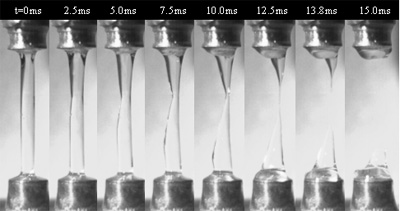
We are currently investigating the behavior of complex fluids such
as entangled wormlike micelle solutions in transient homogeneous uniaxial
extensional flows. In our experiments, a filament stretching rheometer
is used to follow the evolution of the tensile stress and the flow
induced birefringence of a series of CTAB/NaSal and CPyCl/NaSal wormlike
micelle solutions in an extensional flow. The wormlike micelle solutions
demonstrate significant strain hardening and a failure of the stress-optical
law. These fluid filaments have also been found to exhibit a very
interesting failure mechanism. At a critical stress, nearly independent
of strain rate, the wormlike micelle solution filaments fail through
a dramatic rupture near the axial midplane, shown here through a series
of high speed images. This filament failure is not the result of elastocapillary
thinning, but appears similar to the ductile failure of an elastic
solid. We believe that this filament failure stems from the local
scission of individual wormlike micelle chains resulting in a dramatic
failure of the entangled micelle network. Our recent work has shown
that branching in wormlike micelle solutions eliminates extensional
thickening.
To view a high speed movie showing the failure of the fluid filament
please download the following avi file: ctab05_1s.avi
(3.8MB)
Relevant articles can be found on our publications
page.
Formation of Shear
Band structure in Wormlike Micellar Solutions
In conjuction with extensional experiments, we are also exploring
the interesting shear banding behavior in solutions of wormlike micelles.
CPyCl/NaSal wormlike micelle solutions of various concentration have
been explored in shear rheology, and those in the semi-dilute regime
are being studied further in a specially designed large Couette cell.
This Couette was constructed with clear optical access for PIV and
FIB measurements in situ. Velocity and birefringince measurements
indicate the simultaneous co-existence of bands of fluid at both high
and low shear levels. This phenomenon is confirmed by the existence
of a plateau in the shear stress over at least an order of magnitude
in shear rate.
To view a movie of a startup flow (shear rate = 8s^-1), download
the following avi file: CPyCl-100mM-8startup.avi
(6.5MB)
Relevant articles can be found on our publications
page.
|
|
|
|
|
|
|
|
|
|
|
|
|
|
|
|
|
|
|
|
|
|
|
|
|
|
| Flow
Around a Sphere of a Wormlike Micellar Solution |
Many of the flows experienced by wormlike micellar solutions are complex,
containing regions of both shear and strong extensional flows. We
focus the flow of a wormlike micellar solution past a sedimenting
sphere, a prototypical complex flow. The test fluid is a 0.05M CTAB/
0.05M NaSal solution which is characterized both in shear and transient
homogeneous uniaxial extension. A single sphere-to-tube aspect ratio
(a/R = 0.0625) is investigated over a wide range of Deborah numbers.
As the Deborah number is increased, the drag correction factor, K(a/R,
De), is initially found to decrease due to the effects of shear thinning
near the sphere walls. At a Deborah number of approximately De = 1.0,
the drag correction factor reaches a minimum and begins to increase
with increasing Deborah number as a result of the strong extensional
flow in the wake of the sphere. At a critical Deborah number, the
sedimentation of the sphere becomes unsteady.
|
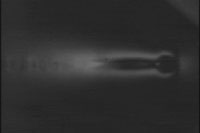
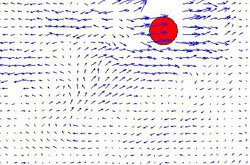
|
Flow visualization, particle image velocity (PIV), Birefringence
measurements are used to analyze flow fields for both the steady and
unsteady sedimentation of the sphere. An attempt is made to correlate
the unsteady behavior of the sphere with the extensional rheology
measurements. Currently, we are very interested in the instability
when the Tungsten ball sediments.
Relevant articles can be found on our publications
page.
|
| |
|
|
|
|
|
|
|
|
|
|
|
|
|
|
|
|
|
|
|
|
|
|
|
|
| Flow
of a Wormlike Micelle Solutions through Porous Media |
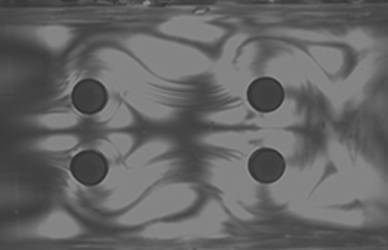
|
|
|
|
|
|
We are currently investigating the behavior of complex fluids (specifically
wormlike micelle solutions) as they flow though a porous medium. This
type of flow field is very common in many day to day situations: how
does shampoo flow through your hair? Additionally, these flows have
important industrial applications such as oil well drilling and recovery
and groundwater remediation. In order to study the kinetics and kinematics
of such flows, we use an idealized porous media: a periodic array
of cylinders. By seeding the test fluid with microscopic reflective
spheres, using a laser for illumination, capturing the fluid motion
with a high speed camera, and using a computer algorithm, we can generate
full field velocity profiles and streamline images. Additionally,
the test fluids we use are birefringent under flow. Accordingly, we
can use polarized light and a camera to capture and process images
highlighting areas of high stress within the fluid. By combining these
techniques with pressure drop measurements, we are able to explore
the behavior of complex fluids under controllable conditions. Our
measurements show a reduction in pressure drop as the fluid shear
thins and enhancement in the pressure drop as the extensional flow
begins to dominate the kinematics. At large rates, the flow becomes
unstable for some, but not all of the wormlike micelle solutions tested.
Relevant articles can be found on our publications
page.
|
Laminar
Drag Reduction and Enhanced Mixing Using Superhydrophobic Surfaces |
|
| |
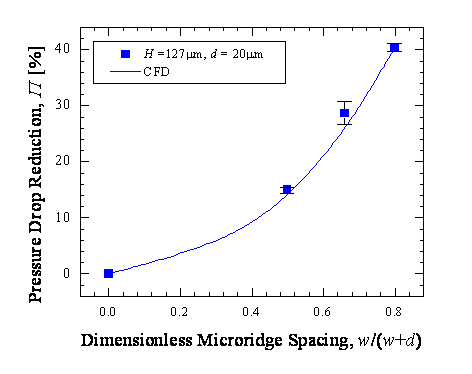
|
|
Superhydrophobic surfaces contain micron or nanoscale hydrophobic
surface structures which result in very large contact angles.. These
surfaces are fabricated with photolithography technology to ensure
the precision of the surface pattern’s geometries and arrangements.
In channel flow, a shear-free air-water interface is formed between
the surface structures which provide some considerable slip velocity
on the hydrophobic surface. By putting these surfaces into micro channels
and mixing cells in different sizes, drag reduction and mixing enhancement
were achieved in laminar flows. Experiment results demonstrated up
to 40% of pressure drop reduction and 20 micron
slip length with the superhydrophobic surface on the bottom of the
channel. The drag reduction effect was increased by optimize the surface
patterns’ designs, and the effect is more obvious in smaller
channels. The slip velocity along the superhydrophobic surface has
been directly measured with micro-PIV. The maximum slip velocity at
the center of the shear-free interface was increased to 60% of the
average velocity by increase the air-water interfaces.
The superhydrophobic surfaces with microridges designs were tested
as a passive mixing enhancement technology in the y-shape mixing cells.
The off axial slip velocity formed secondary flows which stretched
and folded the two species met in the microchannel. Confocal microscopy
was used to image the wholescale flow behavior and the non-dimensionlized
intensity was used to represent the degree of mixing. In the case
of Pe>300, mixing length has been dramatically reduced compare
with the smooth surface. The mixing effects of different pattern designs,
such as the microridges with incremental spacing and angles to the
flow direction, were studied and compared with full scale numerical
simulation models.
Relevant articles can be found on our publications
page.
|
|
| |
|
|
|
|
|
|
|
|
|
|
|
|
|
|
|
|
|
|
|
|
|
|
|
|
| Turbulent
Drag Reduction Using Superhydrophobic Surfaces |
|
|
|
|
Superhydrophobic surfaces,
consisting of micro or nanoscale features on a hydrophobic substrate,
have received considerable attention for their ability to reduce drag
in laminar flows by trapping air between peaks in the surface topology,
producing a shear free interface over a considerable portion of the
surface (See past work of Jia Ou). In the present research we demonstrate
that engineered, micropatterned superhydrophobic surfaces produce the
same effect in turbulent flows. Particle image velocimetry, a direct
velocity measurement technique that correlates successive images of
tracer particles in the flow, is used to measure velocity profiles over
conventional and superhydrophobic surfaces in turbulent channel flow.
Pressure drop measurements are also conducted to directly measure the
drag in the channel. The scope of the project includes designing and
constructing the surfaces and apparatus used in the experiments. A variety
of photolithography, etching and embossing techniques have been utilized.
PIV measurements have measured slip velocities up to 40% of the mean
flow with shear stress reductions up to 60% on a single wall and slip
lengths of 230µm over several microridge geometries. Drag reduction
is found to increase with increasing feature size and spacing, as in
laminar flows, and with increasing Reynolds number. These experimental
results were subsequently confirmed and extended to a host of new superhydrophobic
geometries through Direct Numerical Simulations (DNS). Successful implementation
and commercialization of superhydrophobic surfaces would result in a
significant drag reduction and subsequent fuel savings for marine vessels.
Relevant articles can be found on our publications
page.
|
|
|
|
|
|
|
|
|
|
|
|
|
|
|
|
|
|
|
|
|
|
|
|
|
|
|
Effect
of Slip on Flows Past Superhydrophobic Cylinders and Hydrofoils
|
|
In addition to experiments
in turbulent flows through superhydrophobic channels. We are currently
studying the effect of superhyrophobic surfaces and slip on the flow
past bluff bodies like cylinders, hydrofoils and boats. Superhydrophobic
surfaces are found to have a major impact on both the lift and drag
of hydrofoils and on the vortex shedding dynamics from a cylinders.
Relevant articles can be found on our publications
page.
|
|
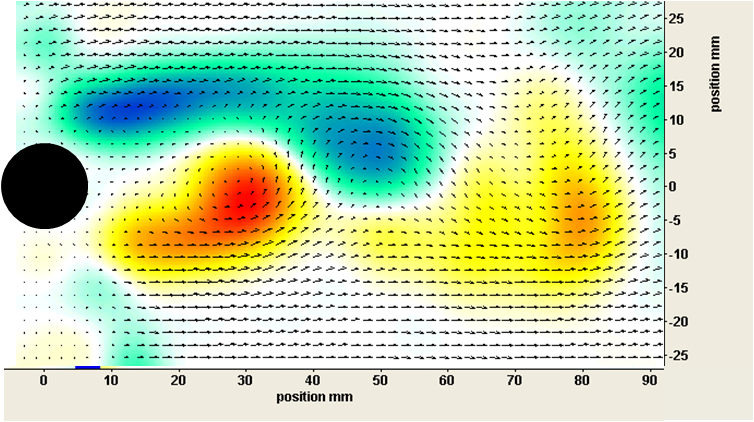 |
| Novel
Techniques for Creating Superhydrophobic Surfaces - Sanding Teflon
|
|
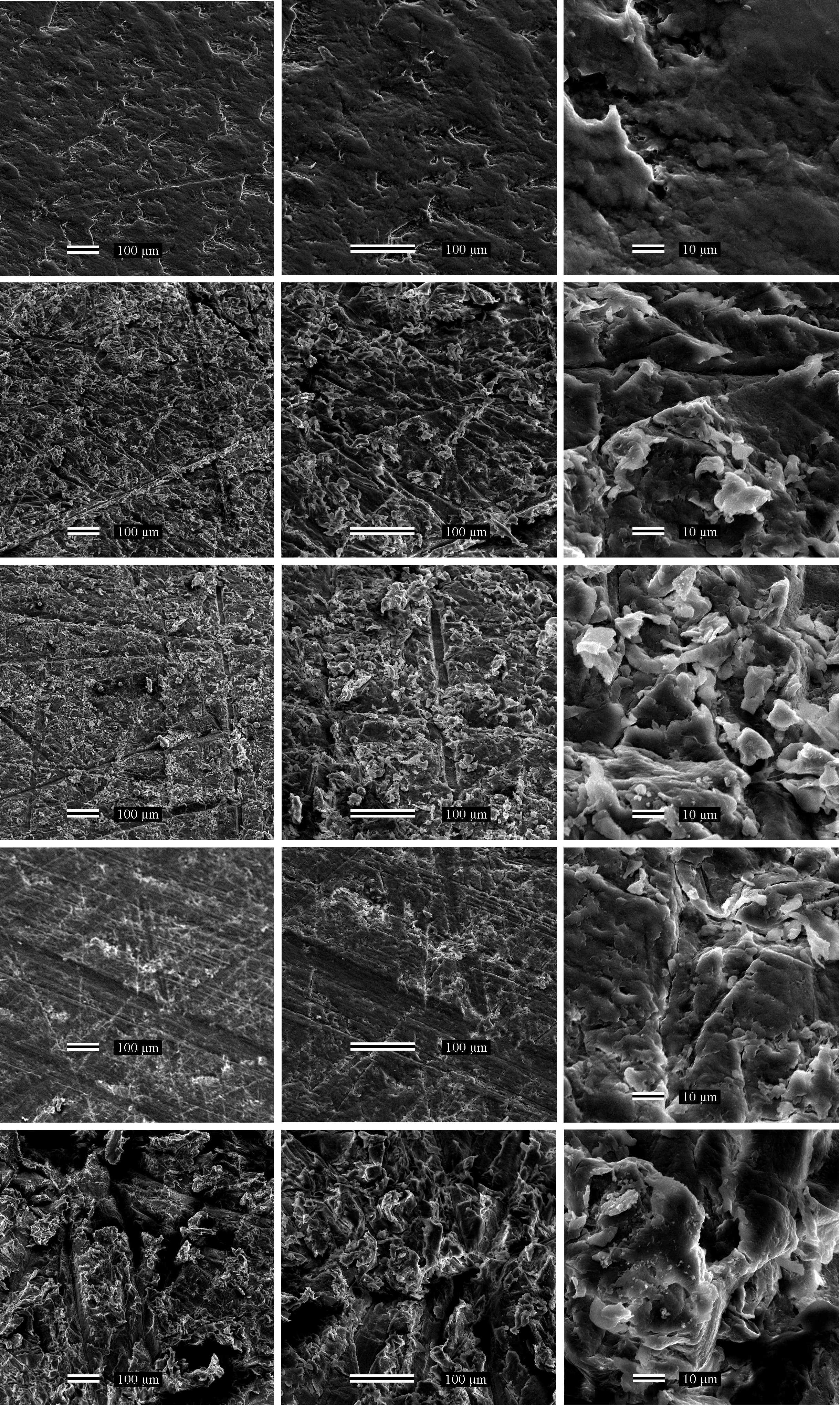 |
We have found
that by sanding Teflon with different grit sand papers we can produce
surfaces with a range of different wetting behavior. These include high
advancing contact angle and high hysteresis surfaces (petal effect -Wenzel
state), high advancing contact angle low hysteresis surfaces (lotus
effect - Cassie state) and everything in between. The SEM to the left
includes shows the results from sanding Teflon with increasing sandpaper
grit number. |
|
|
|
Digital
Microfluidics Using Superhydrophobic Surfaces
|
|
Digital (one drop at a time)
microfluidics is largely understood in enclosed devices. A simpler approach
would be to perform task in an enclosed device on an open surface, specifically
drop positioning, movement, mixing, and sorting. By utilizing the water-repellent
properties of superhydrophobic surfaces, we are investigating the ability
to perform all of those tasks on a flat surface. We have shown that
by sanding Teflon, it is possible to create superhydrobic surfaces with
a range of advancing contacts angles with water and also contact angle
hysteresis. In maintaining a constant advancing contact angle, we can
characterize the effect of contact angle hysteresis on the dynamics
of drop coalescence via high speed photography. We can also use differences
of contact angle hysteresis in various orientations to deflect drops,
and also sort drops in terms of Weber number. Sorting has been achieved
at an optimal Weber number and angle of contact angle hysteresis change
of over 1 drop diameter (see image to the right).
Relevant articles can be found on our publications
page.
|
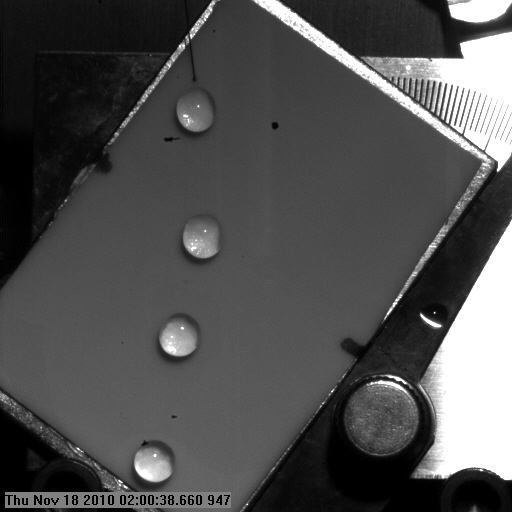 |
|
Capillary
Force Lithography |
|
| Capillary actions of melted polymers
can be used to drive large-area printing of smallscale features. This
low-cost, high efficiency, high resolution fabrication technique has great
potential in micro- and nano- scale fabrication of electronic, optical,
and mechanical devices.
Our understandings of capillary action and more generally equilibrium
in surface-tension-dominated regime is far from thorough. When looking
at the meniscii formed in oddly shaped cavities, such as a capillary
with triangular or star-shaped cross-sections, one is likely to be fascinated
by the richness of geometries, and more importantly, the physics that
leads to them. Here we use an open source software, the Surface Evolver
(SE), to simulate the shape of the equilibrium meniscii formed in various
capillaries. This study has applications in modern micro-nano contact
lithography.
We are also interested in the condensation of liquid droplets on micro-posts.
The efficiency of a condensation device is largely related to the amount
of liquid surface tension can support, which is in turn deternmined
by the three-dimensional geometry of the post. Simulations based on
SE is also performed to investigate what types of goemetries (e.g.,
a square pyramide frustum) are benefitial to maximizing the suported
volume of the liquid droplet.
Relevant articles can be found on our publications
page.
|
|
|
|
|
|
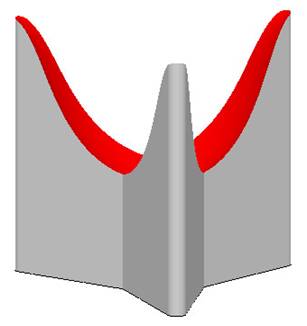
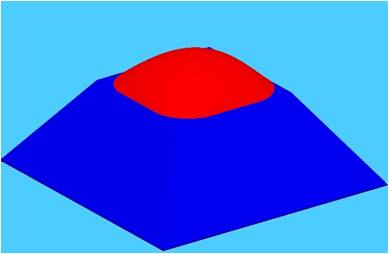
|
|
| |
|
|
|
|
Fabrication
of Hierarchical Structured Surfaces
|
|
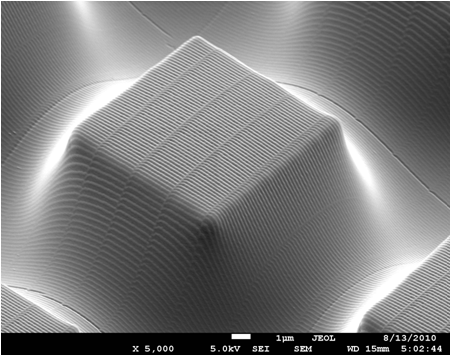 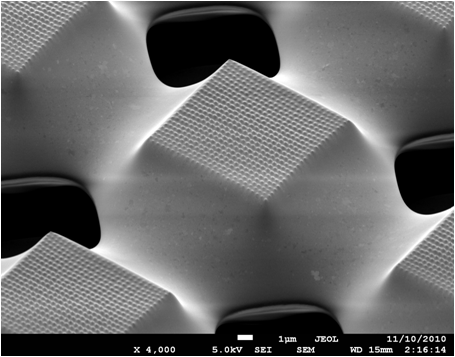 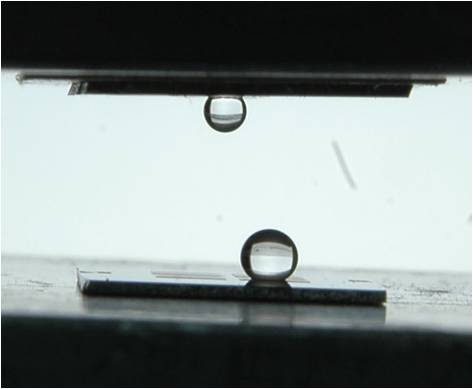
Hierarchical structured surfaces observed in nature have greatly inspried
scientists and engineers in resent years. In this project, our goal
is to better understand the physics behind many seemingly peculiar hydrodynamical
behaviors associated with patterned surfaces, based on which we can
develop novel devices with various desirable properties. Currently,
dual-scale elcetron beam lithography (EBL) is used to fabricate hierarchical
superhydrophobic surfaces with well-defined micro-structures and regular
nano-features. A typical hierarchical structure consists of an array
of 10 micron square blocks with 10 micron spacing as the primary structure
and 100~200nm rigdes or posts with 200~500nm spacing covering the entire
area as the secondary structure. Important geometric parameters including
the size, shape, spacing, and aspect ratio of the primary as well as
the secondary features can be control relatively independantly over
a rather large range. We are also very interested in studying droplet
wicking on a hierachical superhydrophilic surfaces consist of an array
of micron-size ridges as primar features decorated with micron size
bands with nano-size patterns perpendicular to the primary ridges. The
fabrication techniques developed in this project is potentially applicable
to many other reseach fields as well.
Relevant articles can be found on our publications
page. |
|
| |
|
|
|
|
|
|
|
|
|
|
|
|
|
|
|
|
|
|
|
|
|
|
|
|
| Drop Formation and Deformation
in Microfluidic Devices |
|
Micro and nanofluidics
are finding increasing use in the toolbox of nanotechnology because
these systems are driven by the effects of surface tension, diffusion
and viscosity allowing us to probe new phenomena. Microfluidic devices
can be used to create a variety of differently shaped interfaces between
two immiscible fluids, such as jets, drops and planar/parallel interfaces.
Microfluidics droplet production is a well understood process with several
methods for droplet creation commonly used. In most recent work, the
co-flowing stream method of droplet generation was used to create droplets
of deionized water and four aqueous surfactant solutions in oil. The
morphological developments of the drops in extensional flow at various
extension rates were studied using a hyperbolic contraction. This novel
approach to droplet deformation within a microfluidic device allowed
for the probing of droplets within a nearly uniform extensional flow.
The focus of this work was to study the effect of confinement on droplet
deformation and breakup in extensional flows. Droplet deformation was
found to increase with both increasing capillary number and increasing
confinement, with the effect of confinement being quite dramatic. The
addition of surfactant to the droplets resulted in the production of
tails, which streamed from the rear of the droplets and produced daughter
droplets much smaller than the parent droplet. In the low confinement
limit where the flow was purely extensional, a single tail was formed
at the center of the droplets trailing edge. With enhanced confinement,
shear effects from the wall became important, the droplets were observed
to take on a bullet like shape and two tails formed at the trailing
edge of the droplet. The critical value of the capillary number and
confinement needed for the formation of tails varied with the surfactant
used.
Relevant articles can be found on our publications
page. |
|
|
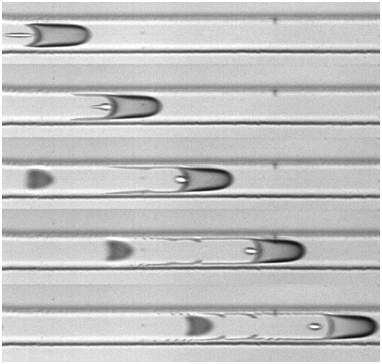
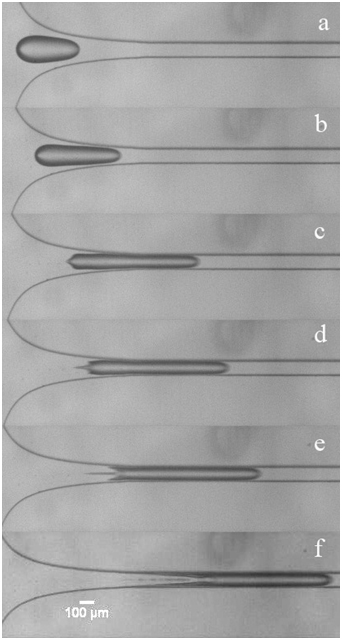
|
|
|
|
|
|
|
|
|
|
|
|
|
|
|
|
|
|
|
|
|
|
|
|
|
|
|
Extensional
Flow Induced Crystallization of Polymer Melts Using a Filament Stretching
Rheometer |
|
We are investigating the effect
of uniaxial flow on the crystallization of a number of different polymers.
An extensional rheometer with a custom-built oven is used to stretch
molten samples at various extension rates and strains. The filaments
are then allowed to crystallize fully before being removed.
Differential Scanning Calorimetry (DSC),is used to measure the crystallinity
of the samples and compare to an unstretched reference. The crystallization
of the polymer is then characterized as a function of extension rate
and strain. Small Angle X-ray Scattering (SAXS) and microscopy through
crossed polarizers is used to qualitatively examine the change in crystal
size, quantity, and structure.
We find that a minimum extension rate is required for flow induced
crystallization to occur and that there is an extension rate for which
flow induced crystallization is maximized. This trend is similar across
multiple different polymers studied in the past. A maximum increase
in crystallization of 19% from the quiescent case was observed for polypropylene.
The increase in crystallinity is likely due to the flow induced orientation
and alignment of tubes of constrained polymer chains in the flow direction.
Relevant articles can be found on our publications
page.
|
|
|
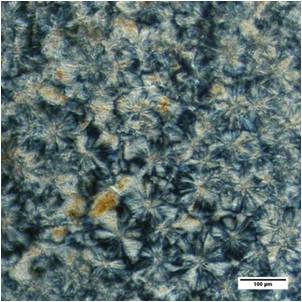
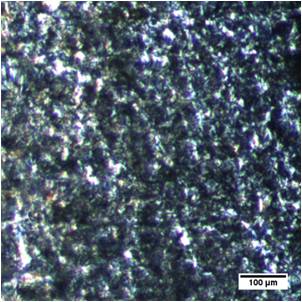
|
|
|
|
|
|
|
|
|
|
|
|
|
|
|
|
|
|
|
|
|
|
|
|
|
|
Sharkskin
Instability in Polymer Extrusion |
Sharkskin is a surface roughness caused during the extrusion of several
polymers such as linear low-density polyehtylene (LLDPE) and polybutadiene
(PBD). First reported in the 1960's, this instability limits the speed
at which the polymer can be extruded, thereby increasing the cost
and energy required to make a viable product. The image to the right
is a typical extrudate strand showing the sharkskin surface instability.
|
|
|
Although this phenomenon has been studied thoroughly in the past
40 years, the focus of our research is to further identify and observe
the mechanism that causes this instability and subsequently reduce
or delay its onset. Current industrial processes use fluoropolymer
polymer processing additives (PPA) to minimize the effects of sharkskin.
This is a very successful method, however in several applications,
the addition of fluoropolymer is undesirable in the final product.
Our research hopes to address this issue by more thoroughly analyzing
the instability in terms of basic rheological properties of the polymer.
For the experimental work, we have fabricated a primitive, but purpose-built
extruder that uses pressurized nitrogen to force the polymer through
interchangeable capillary dies. A range of instrumentation including
pressure transducers and thermocouples, along with visual obersvation
using a CCD camera will be used to monitor the extrudate.
Relevant articles can be found on our publications
page.
|
| |
|
|
|
|
|
|
|
|
|
|
|
|
|
|
|
|
|
|
|
|
|
|
|
|
| Drop
Impacts on a Thin-Film of Surfactant Solution
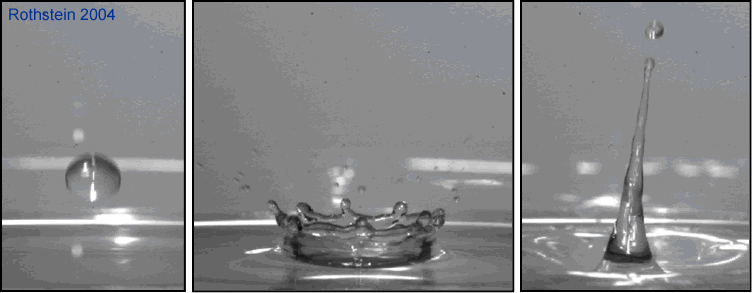
We are studying the impact dynamics of water drops on thin films
of viscoelastic wormlike micelle solutions composed of a surfactant,
cetyltrimethylammonium bromide (CTAB), and a salt, sodium salicylate
(NaSal), in deionized water. We are modifying the composition and
thickness of the thin film is modified to investigate the effect of
fluid rheology on the evolution of crown growth, the formation of
satellite droplets and the formation of the Worthington jet. Some
pictures of a typical drop impact are shown above and movies can be
accessed below. The size, velocity, composition and number of the
impacting drops are varied to study the relative importance of Weber,
Ohnesorger and Deborah numbers and multiple impact on the resulting
dynamis dynamics. The addition of elasticity to the thin film fluid
is found to suppress the crown growth and the formation of satellite
drops with the largest effects observed at small film thicknesses.
Additionally, a plateau is observed in the growth of the maximum height
of the Worthington jet height with increasing impact velocity. It
is postulated that the complex behavior of the Worthington jet growth
is the result of a dissipative mechanism stemming from the scission
of wormlike micelles.
Relevant articles can be found on our publications
page.
|
| |
|
|
|
|
|
|
|
|
|
|
|
|
|
|
|
|
|
|
|
|
|
|
|
|
| Nanoparticle
Encapsolation of Viscelastic Jets
|
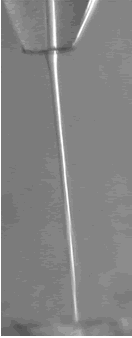
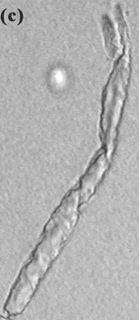 |
|
|
We have developed a number of ways to form
long-lived cylindrical jets of a viscoelastic fluid using hydrodynamic
focusing in a microfluidic device. A solution of polyacrylamide in water
is driven coaxially with immiscible oil and subjected to strong extensional
flow. At high flow rates, the aqueous phase forms jets that are 4 to
90 microns in diameter and several centimeters long. The liquid surfaces
of these jets are then used as templates for assembly of microspheres
into novel rigid and hollow cylinders.
Relevant articles can be found on our publications
page. |
|
|
|
|
|
|
|
|
|
|
|
|
|
|
|
|
|
|
|
|
|
|
|
|
|
| Fluid
Webs: Tearing of Viscoelastic Films |
|
|
|
|
|
|
|
|
|
|
|
|
|
|
|
|
|
|
|
|
|
|
|
|
|
We have performed a detailed series of experiments investigating
the atomization viscoelastic fluid films formed by commercial nozzles
and impinging jets. Images using still and high speed photography
were obtained and analyzed for a wide range of flow strengths and
fluid rheology. The elasticity of the fluid delayed the atomization
of the sheet and the break-up of the rim resulting in the formation
of a new flow structure we call 'fluid webs.'
Download our poster from APS (2MB):
Watch a high
speed movie of the fluid web formation (4MB)
Relevant articles can be found on our publications
page.
|
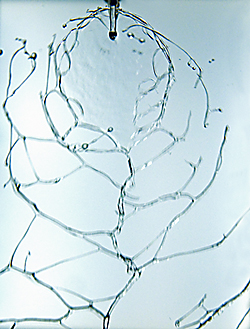
|
|
|
| |
|
|
|
|
|
|
|
|
|
|
|
|
|
|
|
|
|
|
|
|
|
|
|
|
The
Axisymmetric Abrupt Contraction-Expansion |
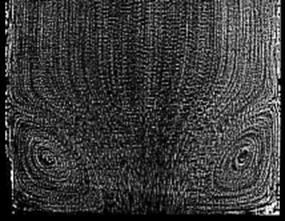
|
|
The image to the left is a pseudo streak image of the extensional flow
of a highly elastic solution through an axisymmetric 4:1:4 contraction-expansion.
The fluid is a 0.025wt% high molecular weight monodisperse polystyrene
dissolved in an oligomeric polystyrene. A pressure drop up to five times
larger than the pressure drop for a similar Newtonian fluid is observed.
|
|
- A movie showing the growth of the enhanced upstream vortex structure
and the onset of an elastic instability, click on the avi file:
4_1_4.avi
(8MB)
- A movie showing the lip vortex growth structure for the 2:1:2
contraction-expansion, click on the avi file: 2_1_2.avi
(5MB)
- A movie showing a dramatic jetting instability just above the
entrance to the contraction plane, click on the avi file:
jetting_instability.avi
(7MB)
Relevant articles can be found on our publications
page.
Thermal Modification
of Elastic Instabilities
|
The image on the right shows the secondary flow developed between
a rotating cone-and-plate rheometer after the onset of a purely elastic
flow instability.
In the research described in the 2001 Physics of Fluids paper
found on the publication page, viscous
heating is employed to modify the stability of the flow of a high
molecular weight polystyrene solution.
|
|
When the characteristic timescale for viscous heating is much longer
than the relaxation time of the test fluid (Na^0.5/De << 1)
the critical conditions for the onset of the elastic instability are
in good agreement with the predictions of isothermal linear stability
analyses. As the thermoelastic number approaches a critical value,
the strong temperature gradients induced by viscous heating reduce
the elasticity of the test fluid and delay the onset of the instability.
At even larger values of the thermoelastic parameter, viscous heating
stabilizes the flow completely.
To see a movie of the secondary flow within the gap between a rotating
cone-and-plate rheometer click on the avi flile, cone-and-plate.avi
(6MB).
Relevant articles can be found on our publications
page.
|
| |
|
|
|
|
|
|
|
|
|
|
|
|
|
|
|
|
|
|
|
|
|
|
|
|
 |
 |
|
Please
email webmaster with any
comments, questions, or suggestions about this website. Thanks!
Site last
updated on
December 22, 2010
|
|

|
|
| |
|
|
|
|
|
|
|
|
|
|
|
|
|
|
|
|
|
|
|
|
|
|
|
|

